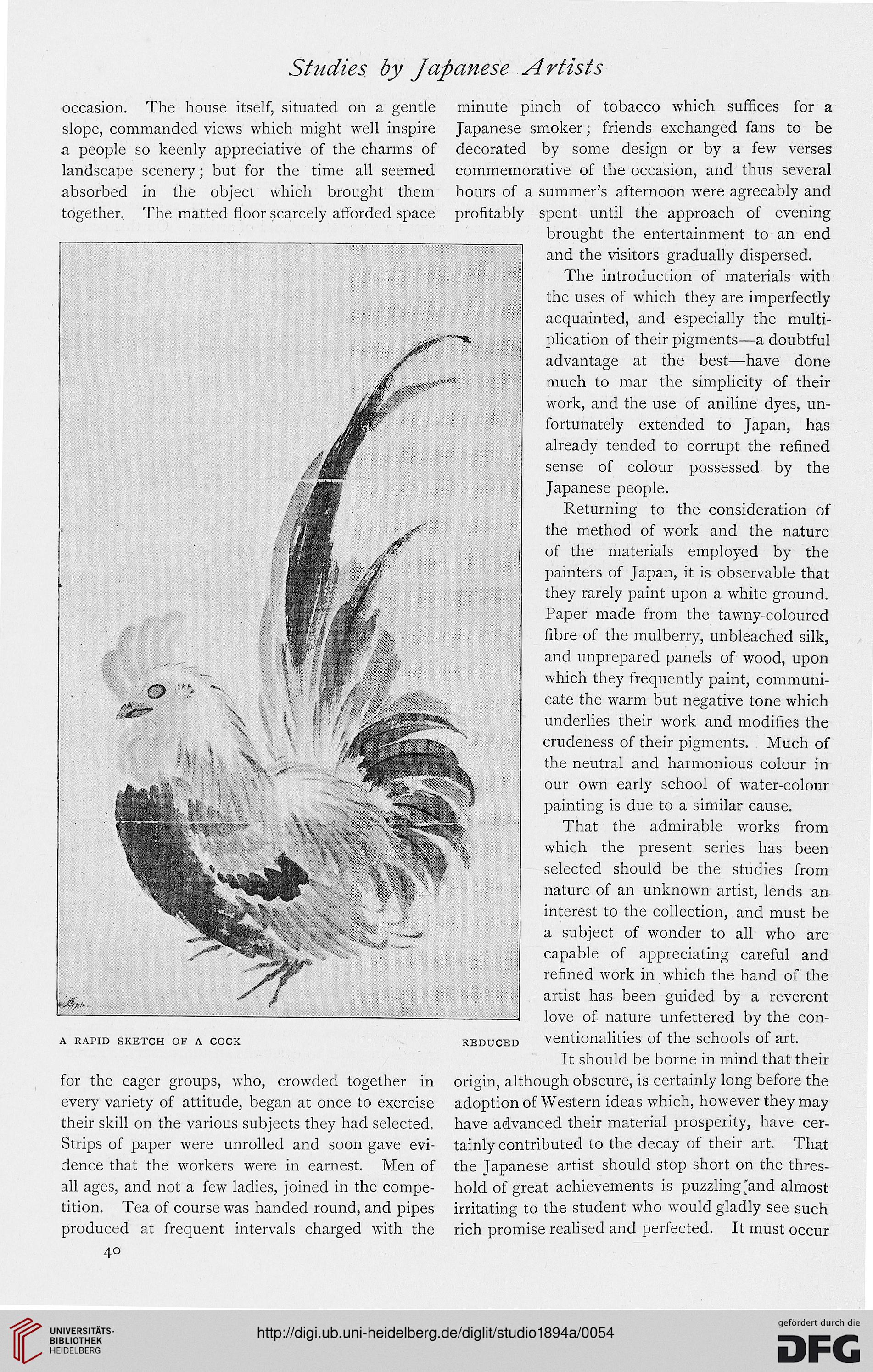Studies by Japanese Artists
occasion. The house itself, situated on a gentle minute pinch of tobacco which suffices for a
slope, commanded views which might well inspire Japanese smoker; friends exchanged fans to be
a people so keenly appreciative of the charms of decorated by some design or by a few verses
landscape scenery; but for the time all seemed commemorative of the occasion, and thus several
absorbed in the object which brought them hours of a summer's afternoon were agreeably and
together. The matted floor scarcely afforded space profitably spent until the approach of evening
brought the entertainment to an end
and the visitors gradually dispersed.
The introduction of materials with
the uses of which they are imperfectly
acquainted, and especially the multi-
plication of their pigments—a doubtful
advantage at the best—have done
much to mar the simplicity of their
work, and the use of aniline dyes, un-
fortunately extended to Japan, has
already tended to corrupt the refined
sense of colour possessed by the
Japanese people.
Returning to the consideration of
the method of work and the nature
of the materials employed by the
painters of Japan, it is observable that
they rarely paint upon a white ground.
Paper made from the tawny-coloured
fibre of the mulberry, unbleached silk,
and unprepared panels of wood, upon
which they frequently paint, communi-
cate the warm but negative tone which
underlies their work and modifies the
crudeness of their pigments. Much of
the neutral and harmonious colour in
our own early school of water-colour
painting is due to a similar cause.
That the admirable works from
which the present series has been
selected should be the studies from
nature of an unknown artist, lends an
interest to the collection, and must be
a subject of wonder to all who are
capable of appreciating careful and
refined work in which the hand of the
artist has been guided by a reverent
love of nature unfettered by the con-
ventionalities of the schools of art.
It should be borne in mind that their
for the eager groups, who, crowded together in origin, although obscure, is certainly long before the
every variety of attitude, began at once to exercise adoption of Western ideas which, however they may
their skill on the various subjects they had selected, have advanced their material prosperity, have cer-
Strips of paper were unrolled and soon gave evi- tainly contributed to the decay of their art. That
dence that the workers were in earnest. Men of the Japanese artist should stop short on the thres-
all ages, and not a few ladies, joined in the compe- hold of great achievements is puzzling'and almost
tition. Tea of course was handed round, and pipes irritating to the student who would gladly see such
produced at frequent intervals charged with the rich promise realised and perfected. It must occur
40
A RAPID SKETCH OF A COCK
occasion. The house itself, situated on a gentle minute pinch of tobacco which suffices for a
slope, commanded views which might well inspire Japanese smoker; friends exchanged fans to be
a people so keenly appreciative of the charms of decorated by some design or by a few verses
landscape scenery; but for the time all seemed commemorative of the occasion, and thus several
absorbed in the object which brought them hours of a summer's afternoon were agreeably and
together. The matted floor scarcely afforded space profitably spent until the approach of evening
brought the entertainment to an end
and the visitors gradually dispersed.
The introduction of materials with
the uses of which they are imperfectly
acquainted, and especially the multi-
plication of their pigments—a doubtful
advantage at the best—have done
much to mar the simplicity of their
work, and the use of aniline dyes, un-
fortunately extended to Japan, has
already tended to corrupt the refined
sense of colour possessed by the
Japanese people.
Returning to the consideration of
the method of work and the nature
of the materials employed by the
painters of Japan, it is observable that
they rarely paint upon a white ground.
Paper made from the tawny-coloured
fibre of the mulberry, unbleached silk,
and unprepared panels of wood, upon
which they frequently paint, communi-
cate the warm but negative tone which
underlies their work and modifies the
crudeness of their pigments. Much of
the neutral and harmonious colour in
our own early school of water-colour
painting is due to a similar cause.
That the admirable works from
which the present series has been
selected should be the studies from
nature of an unknown artist, lends an
interest to the collection, and must be
a subject of wonder to all who are
capable of appreciating careful and
refined work in which the hand of the
artist has been guided by a reverent
love of nature unfettered by the con-
ventionalities of the schools of art.
It should be borne in mind that their
for the eager groups, who, crowded together in origin, although obscure, is certainly long before the
every variety of attitude, began at once to exercise adoption of Western ideas which, however they may
their skill on the various subjects they had selected, have advanced their material prosperity, have cer-
Strips of paper were unrolled and soon gave evi- tainly contributed to the decay of their art. That
dence that the workers were in earnest. Men of the Japanese artist should stop short on the thres-
all ages, and not a few ladies, joined in the compe- hold of great achievements is puzzling'and almost
tition. Tea of course was handed round, and pipes irritating to the student who would gladly see such
produced at frequent intervals charged with the rich promise realised and perfected. It must occur
40
A RAPID SKETCH OF A COCK




